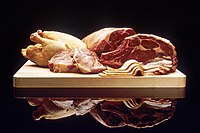
Photo from wikipedia
Most nonhuman primates prey on vertebrates. Meat-eating, defined as ingestion of vertebrate tissue, occurs in 12 families, ≥39 genera, and ≥89 species. It is most common in capuchins (Cebus and… Click to show full abstract
Most nonhuman primates prey on vertebrates. Meat-eating, defined as ingestion of vertebrate tissue, occurs in 12 families, ≥39 genera, and ≥89 species. It is most common in capuchins (Cebus and Sapajus spp.), baboons (Papio spp.), bonobos (Pan paniscus), and chimpanzees (Pan troglodytes) and modestly common in blue monkeys (Cercopithecus mitis), callitrichids (Callithrix spp. and Saguinus spp.), and squirrel monkeys (Saimiri spp.). It is uncommon in other cercopithecines, rare in other haplorhines and in lemurs, and virtually absent in colobines. Birds are the prey class eaten by the most species (≥53), followed by reptiles (≥48), amphibians (≥38), mammals (≥35), and fish (≥7). Major hypotheses for the importance of meat eating are that it is (1) mainly an energy source, especially (1a) when plant-source foods (PSFs) with high energy return rates are scarce (energy shortfall hypothesis); (2) mainly a protein source; and (3) mainly a source of micronutrients scarce in PSFs. Meat eating bouts sometimes provide substantial energy and protein, and some chimpanzees gain substantial protein from meat monthly or annually. However, meat typically accounts for only small proportions of feeding time and of total energy and protein intake, and quantitative data are inconsistent with the energy shortfall hypothesis. PSFs and/or invertebrates are presumably the main protein sources, even for chimpanzees. Support is strongest for the micronutrient hypothesis. Most chimpanzees eat far less meat than recorded for hunter-gatherers, but the highest chimpanzee estimates approach the lowest for African hunter-gatherers. In fundamental contrast to the human predatory pattern, other primates only eat vertebrates much smaller than they are, tool-assisted predation is rare except in some capuchins and chimpanzees, and tool use in carcass processing is virtually absent. However, harvesting of small prey deserves more attention with reference to the archaeological and ethnographic record.
Journal Title: Journal of human evolution
Year Published: 2020
Link to full text (if available)
Share on Social Media: Sign Up to like & get
recommendations!